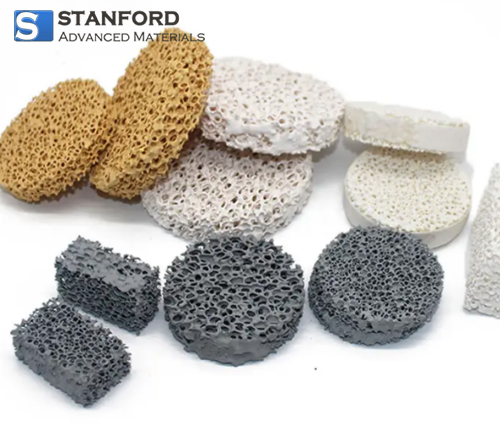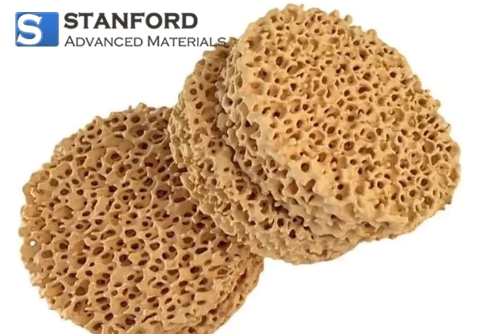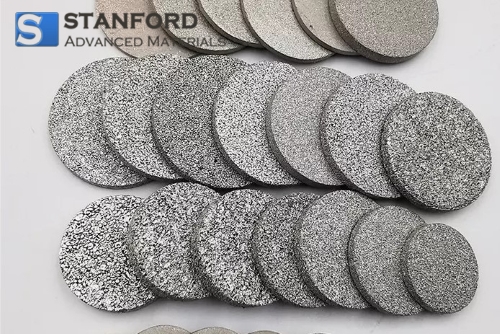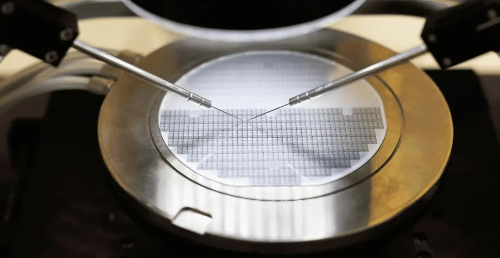Filter Foam Fundamentals: Making the Right Choice
Introduction
In the world of filtration, the choice of material significantly affects the efficiency and effectiveness of the system. Among various options available, filter foam stands out as a versatile and reliable medium.

Figure 1. Different Foam Filters
This comprehensive guide delves into the fundamentals of filter foam. Hope that it can offer insights to help you get foam products tailored to your specific needs.
Understanding Filter Foam
Filter foam is essentially a porous material specifically engineered for filtration purposes. Its unique structure is characterized by a network of cells, which can be either open-cell or closed-cell:
l Open-Cell Structure: In open-cell foams, the tiny cells or pores are interconnected, and they form an open network. This structure allows air, water, and other substances to flow through easily, so such foams are ideal for applications requiring high breathability and fluidity.
l Closed-Cell Structure: Contrarily, closed-cell foams have enclosed cells. These cells do not interconnect. This structure makes the foam more rigid and impermeable, so they are suitable for applications where moisture resistance and structural integrity are paramount.
Types of Filter Foam
Filter foam is also categorized by the type of material it's made from. Each type of filter foam offers unique properties and advantages. They cater to a wide spectrum of filtering needs across various industries. The choice of material affects key properties of the foam, such as its density, porosity, resistance to chemicals, and thermal properties.
Here's an extended overview of the common types of filter foam:
1. Polyurethane Foam:
- Description: Polyurethane foam is open-cell foam. And, it comes with lightweight and flexible characteristics. This type of foam can be manufactured in a range of densities and porosities. So, it can suit various filtration requirements.
- Applications: It is useful for air and water filtration in HVAC systems, automotive filters, and various consumer products. That’s because it is effective in trapping contaminants while allowing fluid flow.
2. Reticulated Foam:
- Description: This foam type possesses a highly open cell structure. Such a structure ensures excellent air and water flow. Reticulated foam is durable and resistant to mildew and chemicals. It is suitable for more demanding filtration applications.
- Applications: It is ideal for use in industrial air filters, aquarium filters, pre-filters in HVAC systems, and as cleaning sponges.
3. Polyethylene Foam:
- Description: Polyethylene foam is closed-cell foam. It is notable for its rigidity, buoyancy, and excellent resistance to moisture and chemicals. Its structure lends it a high level of durability and strength.
- Applications: This foam is rather useful in water filtration systems, packaging materials, flotation devices, and sports equipment where water resistance and structural integrity are essential.
4. Activated Carbon Foam:
- Description: This type of foam excels in filtering gases, odors, and chemical vapors through adsorption. It combines the physical filtration properties of foam with the chemical adsorption capabilities of activated carbon.
- Applications: Activated carbon foam finds common use in air purifiers, odor control systems, and industrial gas filtration. It is capable of trapping a broad spectrum of airborne pollutants.
5. Ceramic Foam:
- Description: Ceramic foam is a porous material with high thermal resistance. It is suitable for high-temperature applications. Its structure allows for efficient filtration at elevated temperatures.
- Applications: Common uses include molten metal filtration, hot gas filtration, and serving as catalyst carriers in industrial processes. A variety of ceramic foams are available on our website (see Table 1).

Figure 2. Zirconia Ceramic Foams
Table 1. Ceramic Foam Products
|
Ceramic Foam Type |
Applications |
Key Properties |
|
Filtration, catalyst Support |
High-temperature resistance, good mechanical strength |
|
|
Thermal barrier coatings, furnace linings, and filters in the casting of metals |
Excellent thermal stability, high melting point |
|
|
Molten metal filtration, flame retardants |
High thermal conductivity, low thermal expansion |
|
|
Thermal insulation, refractory |
High thermal resistance, corrosion resistance |
6. Metal Foam:
- Description: Metal foam is composed of metallic elements. It has a porous structure and a high strength-to-weight ratio. It can be made from various metals, including aluminum, copper, and nickel, each offering unique properties.
- Applications: Metal foam is used in high-temperature filtration, heat exchangers, energy absorption, and some aerospace applications. These devices offer thermal and mechanical properties. SAM features an extensive range of metal foams, as detailed in Table 2.

Figure 3. Titanium Metal Foams
Table 2. Metal Foam Products
|
Metal Foam Type |
Common Applications |
Description |
|
Automotive parts, aerospace, architecture |
Lightweight, strong, good thermal conductivity |
|
|
Batteries, filtration, heat exchangers |
Excellent electrical conductivity, high surface area |
|
|
Catalyst supports, energy storage |
High mechanical strength, corrosion resistance |
|
|
Structural components, sound insulation |
High strength-to-weight ratio, good impact absorption |
|
|
Chemical processing, medical devices |
Very high corrosion resistance, biocompatible |
|
|
Medical implants, orthopedic applications |
Biocompatible, high corrosion resistance |
7. Electrostatic Foam:
- Description: This foam utilizes static electricity to attract and capture dust and other fine particles. It is effective in filtering fine particulates. It is a valuable tool in air filtration.
- Applications: Electrostatic foam is commonly used in HVAC filters, air purifiers, and cooling systems for electronic equipment. In these fields, capturing small particulate matter is essential.
Selecting the Right Filter Foam
Choosing the appropriate filter foam involves considering several factors:
1. Filtration Needs: Determine the particle size you need to filter. Finer particles require higher porosity foam.
2. Environmental Conditions: Assess the operational environment. For instance, foams exposed to high temperatures or corrosive substances require specific material properties.
3. Durability and Maintenance: Consider the lifespan and maintenance requirements of the foam. Durable foams might have a higher upfront cost but lower long-term maintenance.
4. Compliance and Standards: Ensure the foam meets industry-specific standards and certifications.
Conclusion
The selection of the right filter foam is a critical decision. It impacts the efficiency and cost-effectiveness of your filtration system. Filter foam is available in various materials like polyurethane, reticulated, polyethylene, activated carbon, ceramic, metal, and electrostatic. These foams have applications ranging from air and water filtration to soundproofing, odor control, and high-temperature processing.
Stanford Advanced Materials (SAM) is renowned for its expertise in producing and supplying superior-quality filter foams. An extensive range of metal and ceramic foams are available on our website. For more detailed information on foam materials, please check our homepage.








